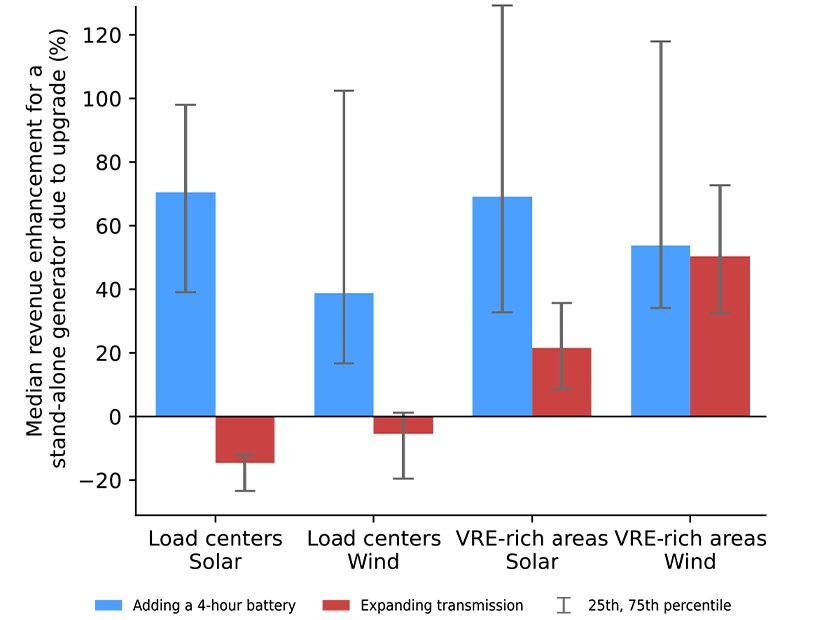
Adding battery storage to wind and solar resources increased generator revenues more than expanding transmission, especially in CAISO and ERCOT, but transmission expansion could relieve congestion in rural areas with plentiful wind and solar capacity, a recent study by the Lawrence Berkeley National Laboratory found.
The first-of-its-kind study assessed the benefits and drawbacks of transmission expansion and adding batteries to renewables in areas with transmission congestion. It looked at the findings from the perspectives of grid operators and generation owners.
“Both storage and transmission can increase grid flexibility, which is critical to the task of balancing system demand with uncertain variable renewable energy supply in real time, though they engage in different types of arbitrage,” the authors wrote.
“Storage shifts energy over time,” they noted. Optimally, batteries charge when electricity is cheap and discharge when prices rise. “Transmission shifts energy from one place to another,” moving lower-cost electricity to where it is needed to meet demand.
“Congestion occurs when transmission limits are reached and prevents low-cost resources from being fully utilized,” the study said. “Even [renewable energy resources], which have extremely low marginal costs of generation, curtail their output due to negative prices in some locations.”
Renewable resources and storage each affect transmission value, and “transmission capacity affects the commercial viability of generation and storage projects,” the study said. “So, understanding the dynamics of interplay between these asset types is essential to effectively plan for the changing grid.”
That is especially important because renewable generation and storage “are increasingly being built at the same locations in hybrid configurations,” it said.
For example, in CAISO, 99% of solar capacity entering the interconnection queue in 2021 was coupled with storage, it noted.
“These changes raise critical questions such as, ‘Will the shift towards hybrid plant deployment reduce congestion on the nearby transmission grid or will the shift necessitate additional actions to alleviate congestion?’” it said.
‘VRE-rich’ Areas
The study analyzed data from 23 locations on the U.S. bulk power system that experience significant congestion and have standalone solar and wind plants. The locations were in CAISO, ERCOT, ISO-NE, MISO, NYISO, PJM and SPP.
The findings from a grid operator’s perspective include:
-
- Standalone wind and solar generators typically alleviate congestion near urban load centers and exacerbate congestion in rural areas with a high number of variable renewable energy (VRE) generators, which the study calls “VRE-rich” areas.
- Standalone storage plants reduce transmission congestion in all areas.
- Hybrid resources with renewable generation and storage alleviate congestion near load centers, but in VRE-rich areas, they can have different effects depending on their exact location and factors, such as whether batteries can charge from the grid.
For generation owners, the study found that:
-
- Transmission expansion is generally a financial detriment to standalone wind and solar plants in load centers and a benefit to those in VRE-rich areas.
- For hybrid resources in VRE-rich areas, expanding transmission typically increases revenue, but there are exceptions.
- In VRE-rich areas, wind plants stand to gain “significantly more from transmission expansion,” while solar plants would benefit more from adding batteries.
“Solar plants in VRE-rich areas [could] expect to benefit from transmission expansion, but this benefit is dwarfed by the potential opportunity from installing storage, especially in CAISO and ERCOT, suggesting solar developers would be more invested in policies promoting hybridization than those focused on transmission,” the study said.
The solar plants in the study with the greatest per-MW revenue increase were in ERCOT ($200,000 to $380,000/MW-year) and CAISO ($50,000 to $91,000/MW-year) — both markets with a large share of solar generation.
The study’s authors said the results highlight the “different stakes that solar and wind developers have in local transmission expansion and how their priorities depend on a plant’s location and configuration.”
The results also “reveal previously unexplored ways in which policy, technology and contract terms related to hybrids can reduce the cost of congestion in local transmission systems,” the study said. “For example, policies incentivizing batteries at congested generation nodes may reduce congestion, since building storage alongside new VRE generators (either in hybrid or standalone configurations) is better, from a congestion perspective, than the standalone generator.
“Further, policies that allow hybrids to charge their storage component from the grid, instead of only from the VRE generator, result in lower costs due to congestion.”


